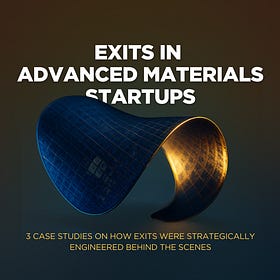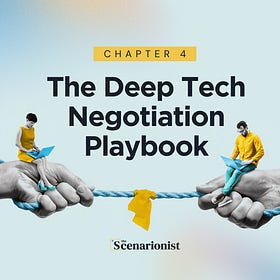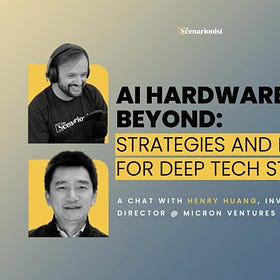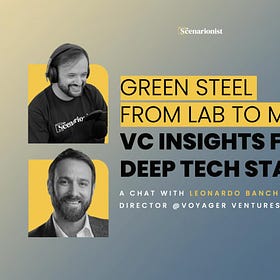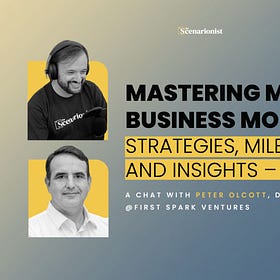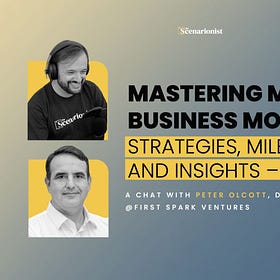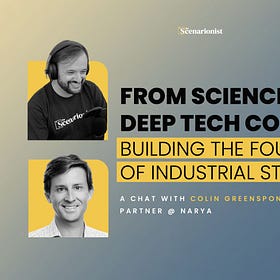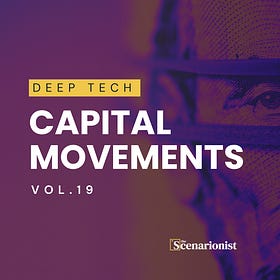Deep Tech Monthly in Review – May 2025
Field Notes from The Scenarionist. A Strategic Recap for Builders and Backers
What We Saw This Month – May 2025
Dear Friends,
If May taught us anything, it’s that deep tech is no longer a promise. It’s a system.
And like any complex system, it’s shifting—slowly, structurally, and out of the spotlight.
Across climate, defense, AI infrastructure, and advanced manufacturing, we watched the market reorganize around friction. Not the hype kind—but the physical, industrial, and geopolitical kind. Billions of dollars moved through fusion, orbital autonomy, green steel, and critical materials. But the real shift wasn’t about the capital—it was about what the capital is now willing to fund.
Venture is returning to physical systems. To assets with inertia, timelines, and teeth.
What once looked uninvestable—military hardware, modular reactors, off-Earth logistics—is now being viewed as a national imperative, a sovereign edge, or an industrial moat.
In defense, we didn’t just see startups. We saw new doctrines. A $2B valuation without public contracts? That’s not a funding story—that’s a positioning play inside tomorrow’s defense stack. Autonomy isn’t just software anymore; it’s payloads, interop, timelines.
In climate, we didn’t just see hope—we saw bottlenecks. Climeworks’ challenges reminded us that climate infrastructure isn’t about ambition, but coordination. Meanwhile, green steel, latent heat storage, and H₂-based fertilizers are showing signs of technical discipline and capital timing finally aligning.
In AI, the most interesting shifts weren’t in models—they were in memory.
Networking. Optical interconnects. The hardware substrate of intelligence itself. What we learned this month is that compute alone won’t scale the future. Bandwidth will. Thermal limits will. And founders who understand systems—not just chips—will build the real moats.
And through it all, the subtext stayed the same:
Less pitch. More production.
Less “what could this be,” more “how will this run.”
The visionaries are still here—but the builders are winning. And the most strategic founders are not chasing hype—they're aligning with policy, infrastructure, and capability gaps.
In May, we curated and published 18 original pieces of intelligence, insights, and educational playbooks—spanning first-hand operator interviews, capital analysis, and strategy deep dives. From AI hardware orchestration to green steel scaling, our aim wasn’t to comment—it was to equip builders with the tools to navigate and deploy in real time.
5 Key Takeaways from our May pieces
1. Venture Is Rediscovering Industrial Friction.
Across sectors, we saw capital gravitate not toward speed or scalability, but toward friction — the kind that comes with regulatory drag, capex intensity, and supply chain inertia. From green steel to fusion, funds didn’t chase simplicity; they underwrote difficulty. The most investable companies in May weren’t the fastest — they were the most operationally grounded.
2. Strategic Autonomy Is Becoming a Market Signal.
Defense tech wasn’t just about hardware this month — it was about positioning. The rise of European and American dual-use unicorns suggests that national interest is reshaping dealflow. Founders that anchor their tech within sovereignty narratives — autonomy, energy resilience, rare earths — are receiving funding not despite their geopolitical complexity, but because of it.
3. Climate Tech Is Entering Its Operational Era.
May marked a transition in climate capital: from promise to production. Climeworks' challenges highlighted the limits of vision without infrastructure. Meanwhile, upstream bets on thermal storage, lignin-based materials, and hydrogen agri-inputs revealed a growing investor preference for climate solutions that map cleanly onto supply chains, policy incentives, and hard engineering milestones.
4. Deep Tech Execution Is Now a Discipline — Not a Vibe.
The best-funded founders in May weren’t necessarily the boldest — they were the most fluent in how things actually get built. Across medtech, advanced materials, and AI-native systems, what stood out wasn’t narrative, but specificity: integration models, reimbursement logic, pilot throughput, and stack interdependencies. Execution isn’t just admired — it’s capitalized.
5. Infrastructure Is the New Stack.
AI hardware stories like Atlas and lab-to-cloud startups showed that innovation is shifting from algorithms to substrates. Founders building tools that underpin compute, fabrication, or deployment logistics are commanding premium attention — not because they’re sexy, but because they’re system-critical. In deep tech today, what you enable often matters more than what you build.
The 3 Macro Trends That Defined May
Industrial Risk Is Emerging as a Strategic Asset
May confirmed what some have quietly anticipated: friction is no longer a red flag — it’s investable.
From autonomous mining systems to grid-compatible fusion hardware, capital is flowing toward domains with high inertia, baked-in regulation, and complexity that’s difficult to replicate.
→ A mid-stage fusion company didn’t raise on scientific promise alone — it raised on regulatory readiness and deployment alignment.
Negotiation Is Shaped by Asymmetry, Not Valuation
The most telling rounds this month weren’t won on pricing power. They were shaped by informational advantage.
Deep tech still moves through mismatches — in knowledge, in timeframes, in expectations. Founders who navigate those mismatches aren’t just defending terms — they’re defining them.
→ One materials startup set investor expectations around throughput KPIs and locked-in supply chain access — not vision slides.
Operating Models Are the New Narrative
The most compelling raises weren’t built on ambition — but precision.
Founders who understand their technical dependencies, scaling friction, and integration realities are closing rounds with speed — and trust.
→ A compute infrastructure team secured funding not on theoretical promise, but on a clear grasp of thermal, bandwidth, and orchestration constraints.
May Recap: 18 Assets to Power Your Deep Tech Advantage
Strategy playbooks, investor intelligence, and operator insights — built for execution.
The Scenarionist exists to equip deep tech founders, investors, and operators with high-signal tools. Every week, we publish sharp, actionable content designed to help you navigate capital cycles, technical inflection points, and industrial-scale deployment.
In May, we released 18 original pieces across 5 strategic streams:
Missed May? Here’s the full collection of everything we published — every insight, briefing, and playbook, right at your fingertips.
✨ INSIGHTS & PLAYBOOKS
Exits in Advanced Materials Startups
Key Lessons:
1. M&A in materials isn't random — it’s architected around integration fit.
2. Timing your exit starts with controlling a chokepoint, not just tech.
3. Strategic buyers care more about stack position than user growth.
AI-Powered Electronics Labs in the Cloud
Key Lessons:
1. Hardware iteration is shifting offsite — cloud-native electronics labs cut dev time from months to days.
2. The next AI infra wave is upstream — not in models, but in the tooling that builds the tools.
3. Four stealth players are converging on the same wedge: platformizing firmware, layout, and signal conditioning for remote teams.
The Deep Tech Negotiation Playbook | Chapter 4/4
Final chapter of our 4-part series
Prep like it matters—because it does:
- Stakeholder mapping
- BATNA and leverage
- Avoiding classic founder traps
- and more...
Bonus Appendix: The Deep Tech Negotiation Playbook
- Negotiation in Action
Four founder cases, four critical inflection points.
- Deep Tech Negotiation Worksheet
A comprehensive, fillable negotiation planning tool.
- 10 Common Objections (and How to Respond)
The fast-response handbook for founder pushback.
- and more...
✨ VC GUIDES
From STEM to Deep Tech VC
Key Lessons:
1. Technical founders can outperform in venture—if they unlearn academic signaling.
2. Sourcing is easier when you can reverse-engineer the stack.
3. The next generation of VCs won’t come from finance—they’ll come from fabrication labs.
✨ DEEP TECH BRIEFING

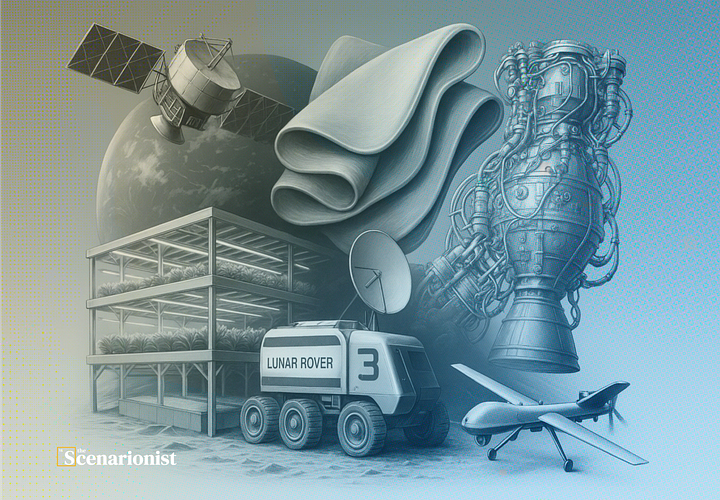

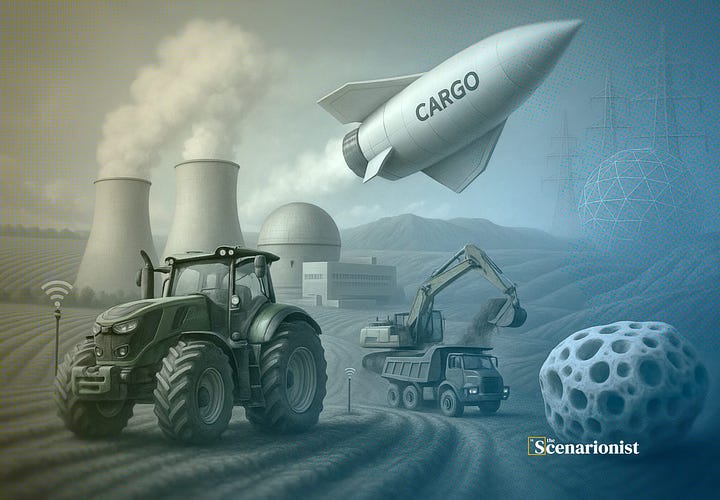
🛡️$2B Defense Unicorn; ⛏️MiningTech Acquisition; 🌱Farming in Orbit; 🪨 Membranes for Rare Earth Extraction; 🚤 Maritime Hardware in 100 Days & more
Key Lessons:
Valuation ≠ revenue. In defense, architectural relevance can define unicorn status.
Mining automation is now acquirable. M&A appetite is moving upstream.
Orbital ag isn’t science fiction—it’s supply chain insulation.
🪨 Rush into Trash-to-Minerals;🛡️New EU Defense Unicorn; 🌖 Lunar Mining Milestone; 🛰️ Japanese Satellite IPO; ⚛️ Google Bets on Early-Stage Nuclear Sites & More
Key Lessons:
Waste valorization is being priced like infrastructure—permits matter more than patents.
Lunar assets are entering sovereign strategy decks—watch for policy-tied capital.
Early-stage nuclear is being judged on siting logic, not tech readiness
🌊AI-“Ocean Drone” ;💨Climeworks Setback; 🇪🇺EIB Billions for Strategic Autonomy; 🧬Genetic Testing M&A; 🥤PepsiCo partner to H2-based fertilisers
Key Lessons:
Edge-AI is real—deployment-ready autonomy is maritime-first.
Climate infra can’t scale without policy-aligned procurement.
Europe is deploying capital upstream—owning inputs, not just outcomes.
⛏️ Mining Goes Autonomous; 🌾 Crop Logic Scales; 🛰️ Orbital Logistics Rise; 🛡️Tactical Autonomy Scales; 🧠 AI Faces the Grid & More
Key Lessons:
Mining autonomy is now an operating model, not a demo.
Tactical autonomy depends on interop and latency, not model size.
Compute scale is now limited by thermals and throughput—not innovation pace.
✨DEEP TECH CATALYST
AI Hardware and Beyond: Strategies and Milestones for Deep Tech Startups | Deep Tech Catalyst
Learn how to map thermal and bandwidth limits before scaling.
Avoid wasted R&D by aligning architecture with deployment sites.
See how investors evaluate infrastructure-aware AI plays.
Green Steel from Lab to Market: VC Insights for Deep Tech Startups | Deep Tech Catalyst
Understand how VCs think about industrial decarbonization risk.
Avoid time mismatches between capex readiness and capital flow.
See how successful teams structure early-stage “hardware-first” deals.
Mastering MedTech Business Models: Strategies, Milestones, and Insights – Part 1 | Deep Tech Catalyst
Learn what investors look for beyond FDA milestones.
Get clarity on how to design for reimbursement pathways early.
Understand where most medtech pitches fail—and how to fix it.
Mastering MedTech Business Models: Strategies, Milestones, and Insights – Part 2 | Deep Tech Catalyst
Avoid the “scaling trap” with real-world pilot design.
See how GTM changes when your buyer is a hospital, not a user.
Learn how to communicate infrastructure fit to capital partners.
From Science to Deep Tech Companies: Building the Foundations of Industrial Startups | Deep Tech Catalyst
Turn academic IP into fundable startups faster.
Learn how to build teams investors actually back.
Avoid “science project” traps with early market integration.
✨ CAPITAL MOVEMENTS
💸 From Seed to Series C: The Sectors Driving This Week’s $1.44B | Capital Movements Vol. 16
Takeaways:
1. Multi-stage capital is concentrating around defense, energy, and compute infra.
2. Funding momentum favors startups aligned with geopolitical and industrial narratives.
3. Late-stage checks are being written early — if integration risk is understood.
Atlas Data Storage, Anysphere, Quantum Systems | Deep Tech Capital Movements Vol. 17
Takeaways:
1. Memory and orchestration layers are now priority bets in the AI-native stack.
2. Dual-use platforms in quantum and sensing are entering institutional territory.
3. Compute bottlenecks are being attacked through systems design, not just silicon speed.
💸 Carbon Cell £1.2M; Realta Fusion $36M; Lignin Industries €3.9M; Zeno Power $50M & more...| Deep Tech Capital Movements Vol. 18
Takeaways:
1. Fusion startups are being evaluated on grid-readiness — not just technical proof.
2. Biomaterials attract capital when they scale with manufacturing reality.
3. Energy platforms with sovereign application layers are accelerating Series A to B.
💸 CellCentric $120M; Rivan £10M; Persist AI $12M; AstroLight €2.8M & more...| Deep Tech Capital Movements Vol. 19
Takeaways:
1. Oncology and AI platforms are raising big on operations, not just IP.
2. Aerospace optics and dual-use sensing are driving new interest at the early stage.
3. Execution infrastructure is now a magnet for capital — not just experimental promise.
The Layer That Compounds
We’re entering a phase where execution beats speculation.
If you're building or backing deep tech, knowing what’s being funded — and why — is no longer optional.
It’s operational.
Every week, we publish deep tech intelligence across capital, climate, AI infrastructure, autonomy, materials, and manufacturing.
Some of it — like our Deep Tech Catalyst strategy series — stays open by design.
It’s our contribution to founders and teams navigating the first transitions from breakthrough science to market readiness.
Other pieces — like Deep Tech Capital Movements — are available to all subscribers for their first 7 days. These updates are built for timing — but their value deepens over time.
After that window, they move into our Premium Archive: a curated, searchable body of investor behavior, capital signals, and strategic patterns. Context doesn’t expire there. It compounds.
And then there’s the rest:
Our Insights, Tactical Resources, Operator Breakdowns, Capital Strategy, Negotiation Frameworks, and Founder Playbooks — the material designed not just to inform, but to support real-world execution.
That’s what lives inside Scenarionist Premium:
A system. A reference layer. A second tier of signal — built for those making decisions within complexity.
Premium members get:
🌟 Weekly: 1 Premium Insight + 1 Tactical Resource — strategy built from execution
📘 Full access to the DeepTech Venture Playbook Library — GTM models, LOIs, integration paths, manufacturing logic
🗂 A growing Archive of every premium piece we’ve published — all indexed, contextual, and built to compound
If you’re already reading us, you’ve likely felt the difference in approach.
Premium is simply the rest of it — and the part that lasts.
Or start free — and upgrade when ready!
The surface keeps you informed.
The second layer lets you execute.
What Our Analysis Revealed — Beyond the Headlines
The headlines this month captured the movement. But the real signal was deeper: not momentum, but structural realignment. Here’s what our May analysis surfaced—beneath the noise, behind the term sheets.
Defense is becoming infrastructure — and Europe knows it.
CHAOS Industries’ $2B valuation wasn’t about revenue, but architecture. And players like EDF and Weir are proving that Europe’s industrial posture is becoming upstream, asset-backed, and sovereign by design.AI isn’t just scaling — it’s embedding.
Ocean drones. Photonic links. Site-native intelligence. It’s no longer about model performance — it’s about deployment geometry and thermal constraints.Industrial energy is crystallizing around heat.
Molten salt reactors. Latent heat buffers. Forget solar panels — decarbonization is shifting toward dispatchable infrastructure.The frontier of value is the edge.
From compute to logistics, the edge is no longer a side case — it’s where orchestration meets margin. And where abstraction fails.The bottleneck isn’t capital — it’s system readiness.
Climeworks and Statkraft reminded us: climate tech doesn’t lack funding. It lacks absorption capacity. The capital is there. The permitting isn’t.Hardware is back — where interface is leverage.
This cycle’s winners aren’t shipping volume. They’re owning integration: chip-to-memory, sensor-to-decision, infrastructure-to-impact.The VC playbook is fragmenting.
Strategic capital is skipping stages. Deployment trumps pitch. Relevance beats traction. And founders who align with capability gaps get funded — fast.Exits are arriving earlier — by design.
Micromine, MGA Thermal, Atomos: they didn’t need unicorn status. They owned critical stack positions — and integration value moves faster than valuation multiples.Narrative fit is the new filter.
Great tech isn’t enough. If your story doesn’t map to procurement logic or sovereign priorities, the term sheet won’t land. Clarity beats ambition.Execution has a new definition.
It’s not MVPs. It’s: Does the system run? Can it fail over? Will it ship? Founders who answer those questions upfront are closing rounds without friction.
Opportunities & Challenges That Surfaced
🟢 Three Emerging Opportunities
Bio-Industrial Platforms Are Gaining Strategic Weight
Startups embedding bio-based materials, diagnostics, or chemistry into existing industrial workflows are no longer seen as vertical niche plays — they’re being valued as infrastructure. The advantage now lies in enabling translation, not invention.Mining Tech Is Turning into a Full-Stack Opportunity
Autonomy in extraction, AI-native logistics, and edge orchestration are converging fast. Founders who can integrate these layers — from subsurface intelligence to real-time routing — are attracting both financial capital and industrial partnerships.Strategic M&A Is Being Driven by Unlikely Players
From consumer goods giants to telecom operators, new categories of buyers are entering the deep tech acquisition landscape. Startups that align early with these unconventional partners can exit faster — often without hitting traditional valuation milestones.
🔴 Three Persistent Challenges
Mismatched Negotiation Still Stalls High-Potential Rounds
Too many founders enter funding conversations without clear stakeholder maps, crisp KPIs, or strong alternatives. The result? Dilution, delays, or deadlock. Negotiation isn’t just about valuation — it’s about asymmetry and preparedness.Permitting and Procurement Block Even Bankable Tech
Great engineering means little without the right policy scaffolding. Regulatory lag, unclear procurement channels, and jurisdictional friction continue to stall deployment — especially in climate and energy infrastructure.Edge Deployment Still Lacks Standard Playbooks
From remote robotics to orbital servicing, edge-native systems are moving fast — but investor frameworks aren’t keeping up. Without common architectural references, these bets remain harder to price, scale, or de-risk.
Wrapping May
If you’ve made it this far, you already know what we’re building.
The Scenarionist is an operating layer — for founders navigating complex stacks, for investors betting on friction, and for teams building where infrastructure, capital, and systems collide.
What we track each week isn’t momentum.
It’s signal.
And signal compounds.
As we always say:
The Scenarionist — Built for the Builders and Backers of real Deep Tech Ventures.
We exist to sharpen your edge. Because when you win, we win — and progress does too. 🚀
— Giulia Spano, PhD & Nicola Marchese, MD





